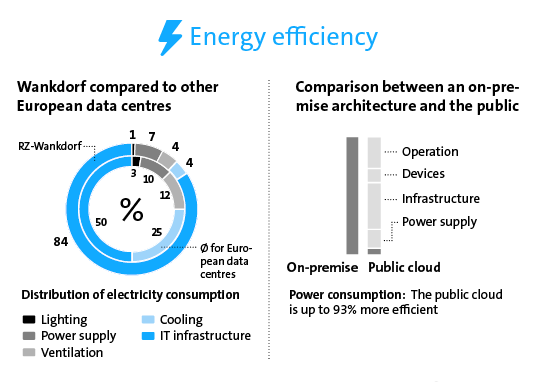Energy efficiency at data centres
How companies save energy with the cloud
As companies generate ever greater volumes of data, the power consumed by their IT infrastructure is also increasing inexorably. Server virtualisation and cloud computing enable enterprises to access data centre resources in energy-efficient manner. A model example: the Swisscom data centre in Wankdorf.
Text: Christoph Widmer, 16 april 2019
By 2025, worldwide data volumes are expected to rise to 163 zetabytes, that is, 163 billion terabytes, a tenfold increase over the 2016 figure. This is the forecast made by the IDC market research institute in a white paper entitled “Data age 2025.” Although private users still account for the majority of generated data volumes, industries such as those engaged in robotics, deep learning or topics like big data and IoT are ensuring that data is increasingly being accumulated in the corporate sector. According to analysts, companies will hold almost 60% of all the stored data by as early as 2025. This data growth will also cause power consumption to skyrocket: according to the Swedish researcher Andres Andrae, this “data tsunami” will result in data centres accounting for 4.5% of global electricity consumption by 2025. In Switzerland, server rooms and data centres already account for about 3% of domestic electricity consumption.
Nevertheless, professional data centres in particular, in which companies access IT resources via hosting and the cloud, are still energy-efficient – especially when compared to in-house servers. Thanks to continuously improving construction approaches and increasingly efficient architecture, large numbers of servers are being operated at data centres – simultaneously and under optimum conditions. Server virtualization enables companies to share resources such as computing power and storage. “Data centres help companies benefit from economies of scale,” explains Rudolf Anker, Swisscom’s Project Manager New Data Centres. “Customers share existing resources and thus also the electricity and maintenance costs. Because the filling degree of the individual servers is also very high, hosting at data centres is not only economically interesting for companies, but also ecologically.”
Thanks to cloud computing, IT resources have even become elastic: customers simply add them with a click of a mouse as and when required. They only pay for what they actually use. Microsoft proves that cloud services also provide especially high energy efficiency: according to the Microsoft Carbon Study 2018, when companies switch from a traditional data centre to the Microsoft cloud, they improve their energy efficiency by 22-93% depending on how they use it. IT operational efficiency certainly contributes to this. But factors such as the architecture of the IT system, the data centre infrastructure and the use and provision of renewable energy also promote sustainability.

Energy efficiency, data centre Wankdorf
The data centre in Wankdorf: energy efficiency par excellence
The same applies to the Swisscom data centre in Wankdorf, which was awarded the Watt d’Or in the renewable energy category in 2015. In Wankdorf, the system temperature is at about 28 degrees Celsius – and therefore higher than at other data centres. “A rule of thumb says that for every degree Celsius by which you cool something down, you need to invest 4% more energy,” Anker explains. “The higher operating temperature alone therefore saves us almost 30% in energy.” Such higher temperatures enable what is known as “free cooling”: freely available refrigeration from the environment is sufficient for cooling, allowing power-guzzling chillers to be dispensed with. And on particularly hot days, collected rainwater is also used for cooling. In addition, waste heat is fed into the new heating network of the city of Berne, while the emergency power generators, which employ kinetic energy storage, do not require acid batteries.
Thanks to these measures, 84% of the employed energy is converted into computing power. This efficiency corresponds to a power usage effectiveness (PUE) ratio – the metric commonly used by experts – of 1.2. Data centres have an average PUE value of 1.9, or 51%.

Newsletter
Would you like to regularly receive interesting articles and whitepapers on current ICT topics?
More on the topic



